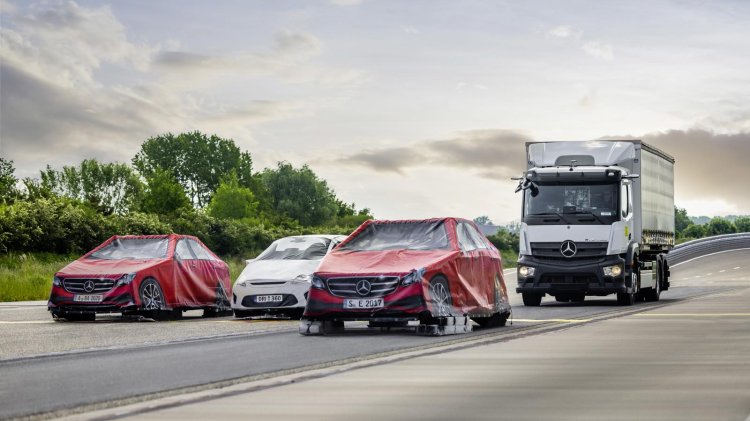Whether it’s emergency braking at the tail end of a traffic jam, added safety when turning right and changing lanes, reducing the risk of skidding (for example when cornering) or taking evasive manoeuvres and many other applications: with safety assistance systems, professional drivers can more easily master numerous – at times dangerous – situations in road traffic, and thus avoid accidents or at least mitigate their consequences.
In this respect, Daimler Truck has always been a pioneer in the industry. The company’s development and testing engineers have been working for decades to provide drivers with the best possible support in their work with the appropriate features and thus further increase the safety of all road users.
Daimler Truck had already installed numerous systems in its various model series long before they were required by law – as is currently the case with the EU Commission’s General Safety Regulation (GSR) 2019/2144, for instance. Since 6 July 2022, the regulation has been specifying that, for new vehicle types from July 2024, more systems must be available as standard equipment for all new vehicles (as part of a gradually enforced obligation of advanced systems).
Setting new benchmarks
The most recent, extensive tests at the EVZ primarily centred on assistance systems that will be used in the various Daimler Truck trucks and buses / touring coaches from April 2024. These include Active Brake Assist (ABA) 6, the new Frontguard Assist, Active Sideguard Assist (ASGA) 2, Active Drive Assist (ADA) 3 and Traffic Sign Assist. With these systems, Daimler Truck is once again underlining its pioneering role in this area and setting new benchmarks in terms of safety. In addition to the Mercedes-Benz Truck Actros, eActros and Atego, test vehicles also include buses/touring coaches from Mercedes-Benz and Setra as well as special trucks such as the Econic or Unimog.
For example, tests are run to see how and when ABA 6 warns and brakes for a cyclist or motorcyclist suddenly crossing or appearing in the lane in front of the vehicle as well as for a vehicle at the tail end of a traffic jam. Tests also included verifications about how the new Frontguard Assist visually and audibly warns drivers of unprotected road users directly in front of the truck, especially in hectic situations, for example when pulling away or at junctions. Further tests focused on how Active Sideguard Assist (ASGA) 2 reacts when turning right if there is a pedestrian or cyclist next to the vehicle. Another test looked at how Active Drive Assist (ADA) 3 automatically guides the truck back into its lane if the driver wants to pull out to the left to overtake, for example, but has overlooked a vehicle approaching from behind.
270 degree sensor fusion technology
The basis for the tested assistance systems is a new electronics platform and thus the so-called sensor fusion involving merging radar and camera data for an even more comprehensive view to the front and side. For this purpose, the electronics platform delivers 20 times higher data processing rates. The six installed sensors – four lateral short-range radar sensors at the front and rear, one long-range radar sensor at the front in the centre and the multifunction camera in the windscreen – now cover 270 degrees around the vehicle. Thanks to the significantly enhanced viewing angle, the already outstanding assistance systems can be even more of a support. At the same time, Daimler Truck and its safety assistance systems go far beyond GSR requirements in many areas. For example, ABA 6 actively intervenes in braking and, at speeds of up to 60 km/h, can automatically brake not only for stationary vehicles, but also for crossing, oncoming road users and road users using the same lane.
High-tech and detailed planning
For the real tests at the EVZ test track in Wörth, state-of-the-art equipment is available for the applications, which are reproduced countless times. These include vehicles equipped with a great deal of high-tech measurement data as well as steering and accelerator pedal robots and GPS-controlled dummies and targets. Before the actual use cases, the sensors required for the assistance systems to be effective are put through their paces in component tests and their functionality is thoroughly tested as part of software-in-the-loop tests. Integration tests are also carried out in vehicle and system tests in the various model series and types.
At EVZ, a wide variety of scenarios can be reproduced in a safe environment, such as the tail end of a traffic jam, overtaking manoeuvres or turning scenarios. And all this on different road profiles that reflect the roads of the world. In this way, we can recreate the same conditions for test vehicles that apply in South America, South Korea, Africa and, of course, Europe.
Tests drives on public roads always form an important basis for validating the systems and functionalities to prepare the measured, safety-relevant data and take the various systems in the model series and types to their limits on the defined test tracks and to explore the limits of driving dynamics. In addition, Daimler Truck development engineers also took a close look at the vehicle functions and systems during the journey to winter testing in Finland at the beginning of 2023. This included the system support when changing lanes as part of Active Sideguard Assist and active lane guidance with Active Drive Assist in the Actros L. Since the journey involved crossing several national borders, it was also possible to analyse the influence of country-specific lane markings, traffic signs and digital map data on the performance of the assistance systems installed in the trucks.
















